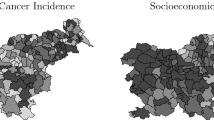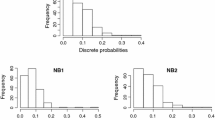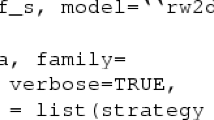Abstract
It is common in geostatistics to use the variogram to describe the spatial dependence structure and to use kriging as the spatial prediction methodology. Both methods are sensitive to outlying observations and are strongly influenced by the marginal distribution of the underlying random field. Hence, they lead to unreliable results when applied to extreme value or multimodal data. As an alternative to traditional spatial modeling and interpolation we consider the use of copula functions. This paper extends existing copula-based geostatistical models. We show how location dependent covariates e.g. a spatial trend can be accounted for in spatial copula models. Furthermore, we introduce geostatistical copula-based models that are able to deal with random fields having discrete marginal distributions. We propose three different copula-based spatial interpolation methods. By exploiting the relationship between bivariate copulas and indicator covariances, we present indicator kriging and disjunctive kriging. As a second method we present simple kriging of the rank-transformed data. The third method is a plug-in prediction and generalizes the frequently applied trans-Gaussian kriging. Finally, we report on the results obtained for the so-called Helicopter data set which contains extreme radioactivity measurements.







Similar content being viewed by others
References
Bárdossy A (2006) Copula-based geostatistical models for groundwater quality parameters. Water Resour Res 42:W11416
Bárdossy A, Li J (2008) Geostatistical interpolation using copulas. Water Resour Res 44:W07412
Bondar I, McLaughlin K, Israelsson H (2005) Improved event location uncertainty estimates. In: Proceedings of 27th seismic research review, pp 299–307
De Oliveira V, Kedem B, Short D (1997) Bayesian prediction of transformed Gaussian fields. J Am Stat Assoc 92:1422–1433
Diggle P, Tawn J, Moyeed R (1998) Model-based geostatistics (with discussion). Appl Stat 47:299–350
Embrechts P, McNeil A, Straumann D (2002), Correlation and dependence in risk management: properties and pitfalls. In: Dempster M (ed) Risk management: value at risk and beyond. Cambridge University Press, Cambridge, pp 176–223
Fang KT, Zhang YT (1990) Generalized multivariate analysis. Springer, Berlin
Genest C, Remillard B (2008) Validity of the parametric bootstrap for goodness-of-fit testing in semiparametric models. Ann Inst Henri Poincare B 44(6):1096–1127
Genest C, Remilliard B, Beaudoin D (2008) Goodness-of-fit tests for copulas: a review and a power study. Insur Math Econ 44:199–213
Hiemstra P, Pebesma E, Twenhöfel C, Heuvelink G (2008) Automatic real-time interpolation of radiation hazards: a prototype and system architecture considerations. Int J Spat Data Infrastruct Res 3:58–72
Hjort N, Omre H (1994) Topics in spatial statistics. Scand J Stat 21:289–358
Ingram B, Cornford D, Evans D (2008) Fast algorithms for automatic mapping with space-limited covariance functions. Stoch Environ Res Risk Assess 22:661–670
Journel A, Deutsch C (1996) Rank order geostatistics. In: Baafi E, Schofield N (eds) Geostatistics Wollongong ’96. Kluwer, Dordrecht, pp 174–187
Journel A, Huijbregts C (1978) Mining geostatistics. Academic Press, New York
Kazianka H, Pilz J (2009) Spatial interpolation using copula-based geostatistical models. In: Atkinson P, Lloyd C (eds) geoENV VII - Geostatistics for environmental applications. Springer, Berlin (in press)
Liebscher E (2008) Construction of asymmetric multivariate copulas. J Multivar Anal 99(10):2234–2250
Nelsen R (2006) An Introduction to copulas. Springer, New York
Pflug G, Römisch W (2008) Modeling, measuring and managing risk. World Scientific, London
Pilz J, Spöck G (2008) Why do we need and how should we implement Bayesian kriging methods. Stoch Environ Res Risk Assess 22:621–632
Pilz J, Kazianka H, Spöck G (2008) Interoperability—spatial interpolation and automated mapping. In: Tsiligiridis T (ed) Proceedings of the 4th international conference on information and communication technologies in bio and earth sciences HAICTA 2008. Agricultural University of Athens, Athens, pp 110–118
Porcu E, Mateu J, Zini A (2004) Nonseparable anisotropic classes of spatio-temporal variograms through Archimedean copulas. Technical report, 75-2004, Universitat Jaume I
Rade L, Westergren B (2004) Mathematics handbook. Springer, Berlin
Rivoirard J (1994) Introduction to disjunctive kriging and non-linear geostatistics. Oxford University Press, Oxford
Saito H, Goovaerts P (2000) Geostatistical interpolation of positively skewed and censored data in a dioxin-contaminated site. Environ Sci Technol 34:4228–4235
Sklar A (1959) Fonctions de repartition a n dimensions et leurs marges. Publ Inst Stat Univ Paris 8:229–231
Song P (2007) Correlated data analysis. Springer, New York
Song P, Fan Y, Kalbfleisch J (2005) Maximization by parts in likelihood inference. J Am Stat Assoc 100:1145–1167
Spöck G, Kazianka H, Pilz J (2009) Bayesian trans-Gaussian kriging with log-log transformed skew data. In: Pilz J (ed) Interfacing geostatistics and GIS. Springer, Berlin, pp 29–44
Stöhlker U, Dubois G, De Jesus J, Burbeck S, Bleher M, Pebesma E (2009) Real-time mapping for environmental surveillance: a decision-maker’s perspective. In: Hristopoulos D (ed) Proceedings of StatGIS 2009/CD, Technical University of Crete, Chania
Varin C (2008) On composite marginal likelihoods. AStA Adv Stat Anal 92:1–28
Acknowledgements
Copula-based spatial modeling and interpolation for continuous marginals is implemented in the \(\tt{R}\) statistical software as part of the \(\tt{intamap\,R}\)-library which is freely available from https://sourceforge.net/projects/intamap. IDW, Automap, PSGP and TGK are also implemented in this library. This work was partially funded by the European Commission, under the Sixth Framework Programme, by the Contract N. 033811 with DG INFSO, Action Line IST- 2005-2.5.12 ICT for Environmental Risk Management. The views expressed herein are those of the authors and are not necessarily those of the European Commission.
Author information
Authors and Affiliations
Corresponding author
Rights and permissions
About this article
Cite this article
Kazianka, H., Pilz, J. Copula-based geostatistical modeling of continuous and discrete data including covariates. Stoch Environ Res Risk Assess 24, 661–673 (2010). https://doi.org/10.1007/s00477-009-0353-8
Published:
Issue Date:
DOI: https://doi.org/10.1007/s00477-009-0353-8




